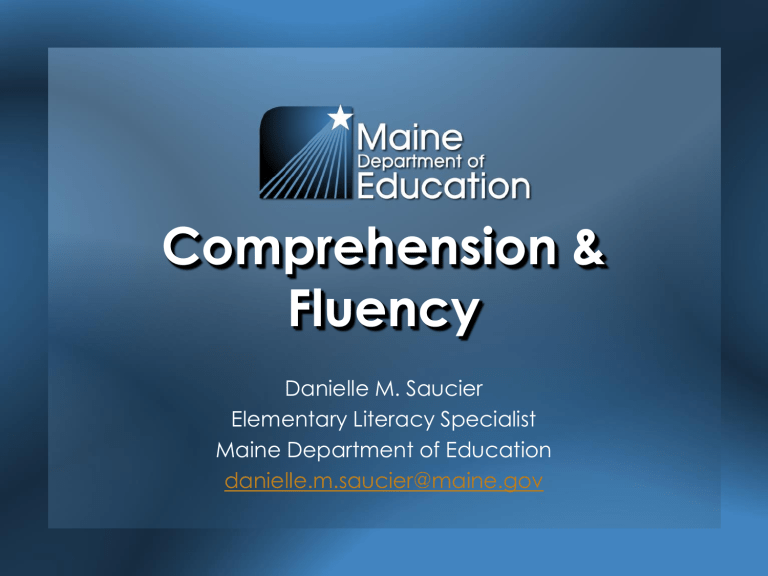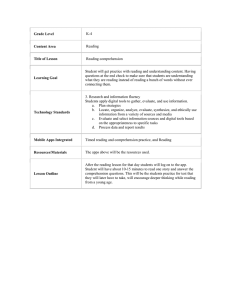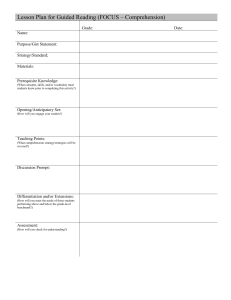
Comprehension & Fluency Danielle M. Saucier Elementary Literacy Specialist Maine Department of Education danielle.m.saucier@maine.gov Welcome Thank you for our continued interest and participation Final session May 28, 2020 – Writing Reminder – Zoom Protocols Mute Questions in Chat Box Reading Is Key Expand ones own learning of topics of personal interest Develop creative thinking Expand vocabulary and spelling Increase success in foundational academic subjects Crucial Comprehension Weak comprehension skills come to the front in grades 3-4 when students begin to become more responsible for learning from what they read. Less teacher framing and structure as students get older – comprehension weaknesses show up in all subjects Indicators of Strong Readers Predict what happens next in a text Self-monitor for understanding Self-question key text elements – main idea, message, plot, sequence, content, characters. Clarify unclear parts of a text Make connections between a text and personal prior knowledge and experiences Places Weak Readers Struggle Lack of organized reading strategies Unclear purpose for reading or knowledge of approach for a certain type of text Weak background knowledge to make authentic connections Limited vocabulary knowledge can hinder deep comprehension Lack of interest or engagement because reading is difficult – frustration and low self-confidence Comprehension . Thinking guided by print (Perfetti, 1995) Challenge of comprehension is the necessity for students to combine the structures of text, the words on the page, the context of the story and their own experiences and knowledge to bring meaning to print. Reading Comprehension Instruction Be certain to keep other foundational skill instruction in mind – Phonological Awareness, Phonics, Vocabulary & Spelling foundations lead to students reading for meaning of texts. Language and listening comprehension are also foundational skills for reading comprehension. Components of Reading Comprehension Instruction Actively engage students by varying activities, texts and supports Teach comprehension strategies Give students ample opportunity to practice using strategies in real texts and monitor for understanding Skills vs. Strategies Skills StrategiesRight and Wrong Answer Values student thinking Action done primarily after reading Done before during and after reading Assesses ability to comprehend specific text Can be used to better understand any text Reading Comprehension Strategies 1. 2. 3. 4. 5. 6. 7. 8. Summarizing Questioning Story mapping Monitoring Question answering Graphic organizers Mental imagery Prior knowledge -Shanahan Summarizing Students identify what is important in the text by: retelling short parts of the text identify crucial details practice identifying crucial and irrelevant information in the text locate key words and phrases that are meaningful to the summary identify the main idea Questioning Students generate question before reading to increase interest and motivation as well as activate background knowledge and schema. During reading students learning to ask questions to themselves and others in order to focus on meaning and important points throughout the text. After reading questions can deepen understanding of the text and clear confusions. Questioning can lead to deep conversations. Story Mapping In story structure instruction, students learn to identify the categories of content Monitoring Students monitor their own thinking and understanding and make actionable decisions about what to do when they don’t understand • Identify what is not understood • Stop at the end of a smaller section of text to monitor for understanding • Use fix-up strategies Question Answering Answering questions can: • Give students a purpose for reading • Focus students’ attention as they read • Help students be active thinkers • Help students self-monitor comprehension • Make connections to what students know 4 Types of Questions (Reading Rockets): • Right There • Think and Search • Author and You • On Your Own Graphic Organizers Illustrate concepts and relationships between concepts in a text or using diagrams. Mental Imagery Visualize parts of the story in ones mind to increase understanding. • Talk about particularly descriptive information • Share the image and compare people’s images • Keep track of how images change as students continue to read • Practice and encourage students to integrate on their own Prior Knowledge All of the experiences readers have had, including information they have learned. This knowledge is used to bring texts to life and to make them more relevant to the reader – activating allows students to make more connections to the new information with connections that allow them to access their schema. Help students “think about their thinking” Fluency Fluency is “reasonably accurate reading, at an appropriate rate, with suitable expression, that leads to accurate and deep comprehension and motivation to read” (Hasbrouck & Glaser, 2012, p. 13). Fluency is NOT just reading words fast. Building Fluency Don’t abandon foundational instruction of phonemics, high-frequency word practice & vocabulary. Provide extensive opportunities for students to read and reread texts – practice orally • Practice with shorter familiar passages • Read familiar poems and song lyrics • Practice short highly used phrases • Reader’s Theater Building Fluency Expand vocabulary instruction in the context of authentic reading – engage in rich discussions about words and building meaning Provide access to media and models that allow students to hear fluent reading • Reading along with audio books and videos • Shared Reading • Echo Reading Resources & Additional Information Florida Center for Reading Research – www.fcrr.org Resources – Student Center Activities Reading Rockets Intervention Central – www.interventioncentral.org Academic Interventions Thank You https://bit.ly/2AGOKob danielle.m.saucier@maine.gov




